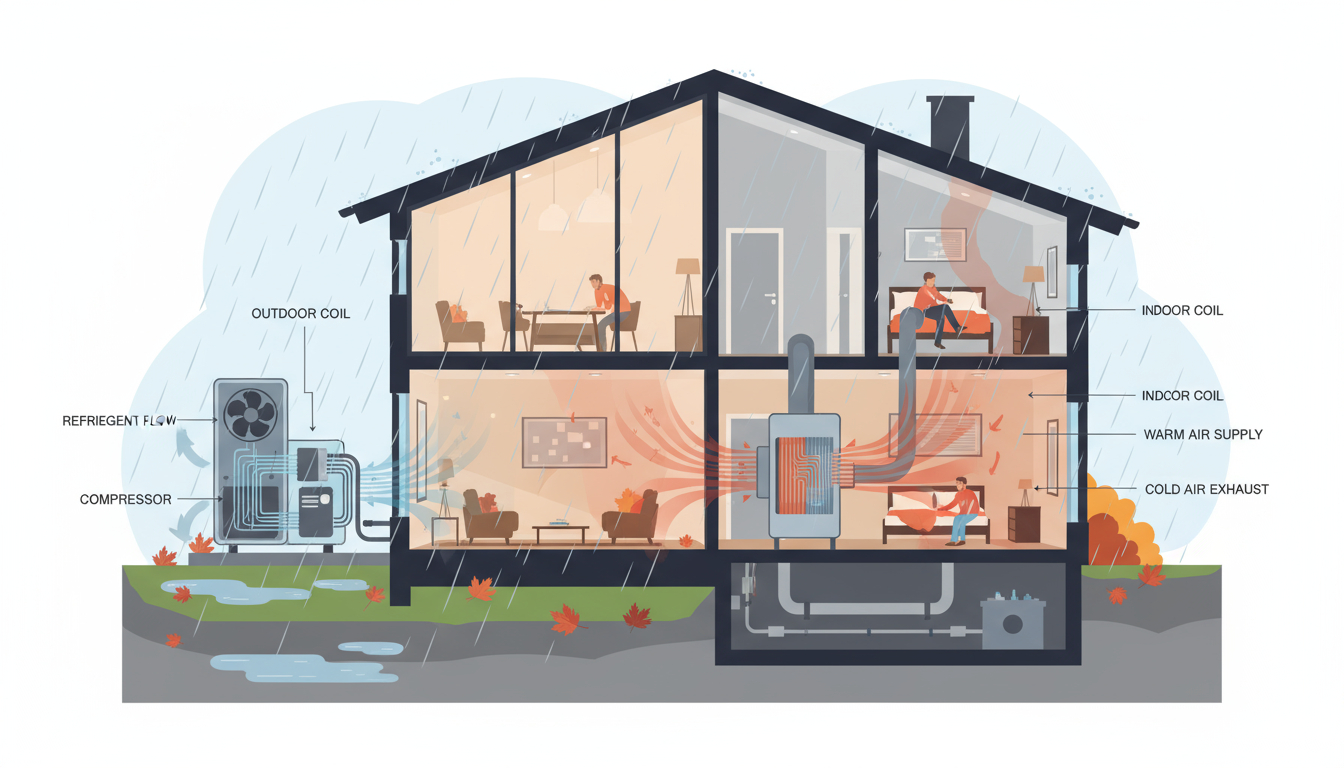

Living in Arizona means dealing with scorching summers that can push temperatures above 110°F and mild winters that rarely dip below freezing. In this climate, your home’s heating, ventilation, and air conditioning (HVAC) system plays a crucial role in keeping you comfortable year-round. If you’re exploring energy-efficient options, heat pumps in Arizona stand out as a smart choice. Unlike traditional air conditioners or furnaces, heat pumps offer dual functionality—heating and cooling—in one efficient unit. This guide breaks down everything you need to know about heat pumps, from how they work to their benefits in the desert climate, helping you decide if they’re right for your home.
Whether you’re building a new residence in Phoenix, upgrading an older system in Tucson, or simply tired of skyrocketing utility bills, understanding heat pumps can solve common HVAC headaches. We’ll cover their mechanics, types, installation considerations, and troubleshooting tips tailored to Arizona’s unique environment. By the end, you’ll have actionable insights to improve your home’s comfort and efficiency.
How Do Heat Pumps Work?
At their core, heat pumps transfer heat rather than generate it, making them incredibly efficient. Imagine a refrigerator that cools your food by moving heat outside— a heat pump does something similar but on a larger scale for your entire home.
The process starts with the evaporator coil, where a refrigerant absorbs heat from inside your home during cooling mode (perfect for Arizona’s brutal summers). The compressor then pressurizes the refrigerant, raising its temperature, and sends it to the condenser coil outside. Here, the hot refrigerant releases heat into the outdoor air, cooling the indoor space as the refrigerant cycles back. In heating mode, the system reverses: it pulls heat from the outdoor air—even in cooler Arizona nights—and brings it indoors.
This cycle relies on thermodynamics, specifically the refrigeration cycle, which has been refined since the 1940s. In Arizona, where outdoor temperatures fluctuate wildly, heat pumps excel because they don’t burn fuel like gas furnaces. Instead, they use electricity to move heat, which can be up to 300% more efficient than resistive heating. For homeowners facing inconsistent power from solar setups common in the Southwest, this reliability solves energy dependency issues.
One key challenge in hot climates is efficiency loss when temperatures soar. Modern heat pumps incorporate variable-speed compressors that adjust output, maintaining performance even at 115°F. If your current AC struggles during peak heat, a heat pump could provide consistent cooling without overworking the system.
Types of Heat Pumps Suitable for Arizona Homes
Not all heat pumps fit every climate, so Arizona residents need options designed for high-heat environments. The three main types are air-source, ground-source (geothermal), and water-source heat pumps.
Air-source heat pumps are the most common and affordable for Arizona. They draw heat from the outdoor air, making them ideal for the state’s dry air and moderate winters. Look for models with a high Seasonal Energy Efficiency Ratio (SEER) rating—aim for 16 or higher to handle Phoenix’s summer peaks. These units install easily on rooftops or ground pads, solving space constraints in urban homes.

Ground-source heat pumps, or geothermal systems, use the stable underground temperature (around 55-60°F in Arizona) for heat exchange. Pipes buried in loops extract or deposit heat, offering superior efficiency in variable climates. While upfront costs run $20,000-$30,000, they slash long-term energy bills by 50-70%, a boon for eco-conscious Flagstaff residents. Installation involves drilling, but rebates from Arizona’s energy programs can offset expenses.
Water-source heat pumps pull from nearby water bodies, but they’re less practical in arid Arizona unless you have a well or pond. For most, air-source suffices.
Choosing the right type depends on your home’s size, soil conditions, and budget. In Scottsdale’s rocky terrain, air-source might be simpler, while geothermal shines for larger properties seeking maximum savings.
Benefits of Heat Pumps in Arizona’s Climate
Arizona’s desert environment amplifies the advantages of heat pumps. First, they provide both heating and cooling, eliminating the need for separate systems. During mild winters, a heat pump gently warms your home without the dryness of forced-air furnaces, reducing allergy flare-ups common in dusty areas like Yuma.
Energy efficiency tops the list. Heat pumps use 50% less electricity than traditional ACs for cooling, crucial when Arizona’s average summer electric bills hit $200+. With the state’s push toward renewables—over 30% of power from solar—heat pumps pair perfectly, minimizing your carbon footprint. The U.S. Department of Energy notes they can cut heating costs by up to 50% compared to gas systems, vital as natural gas prices rise.
Improved indoor air quality solves another Arizona problem: monsoon-season humidity and dust. Many models include advanced filters and dehumidifiers, preventing mold in stucco homes. Plus, they’re quieter than old window units, ideal for peaceful evenings in Sedona.
For families, zoning capabilities allow customized temperatures room-by-room, addressing hot spots from poor insulation in older adobe-style builds. Overall, heat pumps enhance comfort while tackling Arizona’s energy challenges head-on.
Heat Pumps vs. Traditional HVAC Systems
Wondering if a heat pump upgrade is worth it? Let’s compare.
Traditional central ACs excel at cooling but falter in heating, often requiring a separate furnace. This dual setup increases maintenance and inefficiency—furnaces lose heat through vents, while ACs guzzle power in Arizona’s heat. Gas furnaces also emit indoor pollutants, a concern in wildfire-prone areas.
Heat pumps consolidate everything into one unit, reducing repair calls and space needs. Efficiency-wise, a standard AC has a SEER of 13-14, but heat pumps reach 20+, translating to $300-$500 annual savings on bills. In cold snaps (rare but possible in northern Arizona), supplemental heat strips kick in seamlessly.
Upfront, heat pumps cost $4,000-$8,000 installed, versus $3,000 for AC alone, but federal tax credits up to $2,000 (via the Inflation Reduction Act) level the field. For problem-solving, heat pumps avoid gas line hassles and combustion risks, safer for earthquake-vulnerable regions.
| Feature | Heat Pump | Traditional AC + Furnace |
| Efficiency (SEER) | 16-25 | 13-16 (AC only) |
| Dual Function | Heating & Cooling | Cooling only (needs add-on) |
| Annual Cost Savings | Up to 50% | Baseline (higher bills) |
| Environmental Impact | Low (electric, renewable-compatible) | Higher (gas emissions) |
| Best for Arizona | Year-round use in variable temps | Summer cooling only |
In short, for Arizona’s climate, heat pumps outperform by solving inefficiency and versatility gaps.
Installation and Maintenance Tips for Arizona Homes
Proper installation ensures longevity—expect 15-20 years from a quality heat pump. In Arizona, hire licensed contractors familiar with local codes, like those permitting ductless mini-splits for retrofits in historic Tucson homes.
Site your outdoor unit in shade to combat direct sun, and ensure 2-3 feet clearance for airflow. Ductwork matters: seal leaks to prevent energy loss in insulated Southwest homes. For new builds in Mesa, integrate smart thermostats for remote control during heatwaves.
Maintenance prevents breakdowns. Clean filters monthly to handle dust storms, and schedule annual professional tune-ups—check refrigerant levels and coils for corrosion from alkaline soil. Arizona’s hard water can scale evaporators, so use softeners if needed.
Common pitfalls? Undersized units strain during monsoons, leading to higher humidity. Solution: Perform a Manual J load calculation for precise sizing. Budget $150-$300 yearly for upkeep, saving thousands in repairs.
Energy Efficiency and Cost Savings in Arizona
Heat pumps shine in energy savings, especially with Arizona’s tiered electric rates that penalize high usage. A 3-ton unit might save $400 yearly over an old AC, per Energy Star estimates. Pair with ceiling fans and LED lights for compounded effects.
Incentives boost ROI: Arizona Public Service offers rebates up to $1,000, plus net metering for solar-integrated systems. Calculate payback in 5-7 years, faster with rising energy costs (up 10% in 2024).
For off-grid enthusiasts in remote areas like Kingman, heat pumps’ low draw supports battery storage, solving power outage woes during storms.
Common Problems with Heat Pumps in Arizona and Solutions
Even reliable systems face issues. In extreme heat, low refrigerant causes poor cooling—symptom: warm air from vents. Solution: Call a tech for a leak check; recharge prevents compressor failure.
Dust buildup clogs coils, reducing efficiency. Clean quarterly with a soft brush. For icing in rare cold snaps, defrost cycles activate automatically, but ensure proper drainage to avoid water damage.
Noise from vibrations? Secure the unit on a stable pad. High bills signal duct leaks—use a blower door test to seal them.
Proactive fixes keep systems humming, extending life and comfort.
Choosing the Right Heat Pump for Your Arizona Home
Assess your needs: Square footage, insulation, and sun exposure guide selection. For a 2,000 sq ft Phoenix home, a 2-3 ton air-source unit with 18 SEER suits most. Brands like Carrier or Trane offer Arizona-tested models with warranties up to 10 years.
Consult a local expert for a site audit—factors like elevation in Prescott affect performance. Prioritize Energy Star-certified units for rebates.
In summary, heat pumps transform Arizona living by delivering efficient, dual-purpose climate control. They address high energy costs, inconsistent temperatures, and maintenance woes with smart, sustainable solutions. If you’re ready to upgrade, professional guidance ensures the best fit.
For expert installation and service of heat pumps in Arizona, contact Emergency Master Plumbing & Air at 623-584-4706. Their team specializes in reliable HVAC solutions tailored to the desert climate, helping Phoenix-area homeowners stay cool and save.
